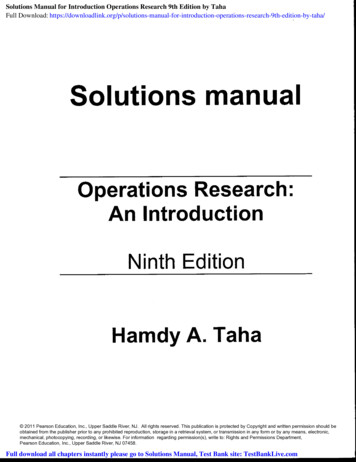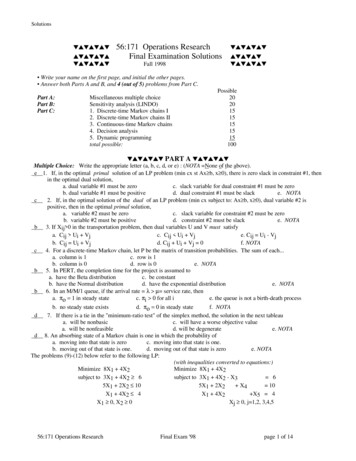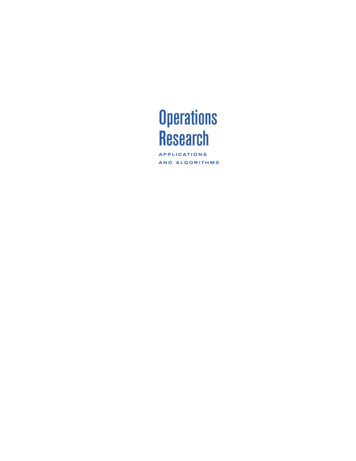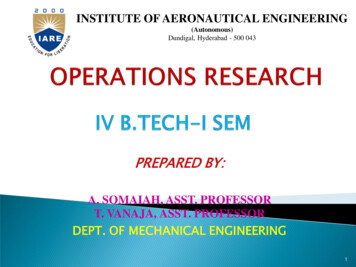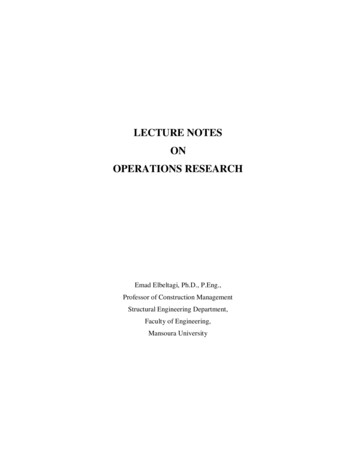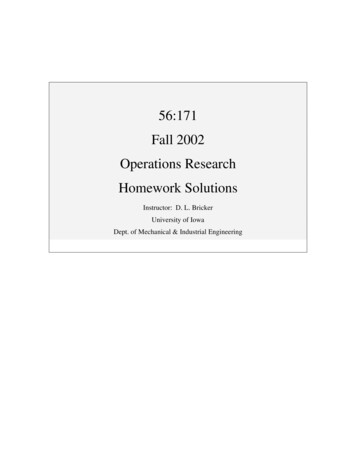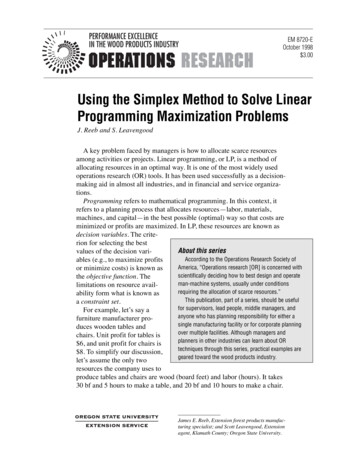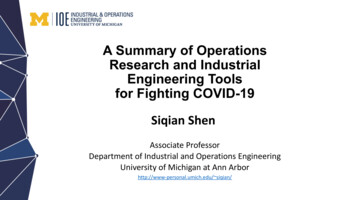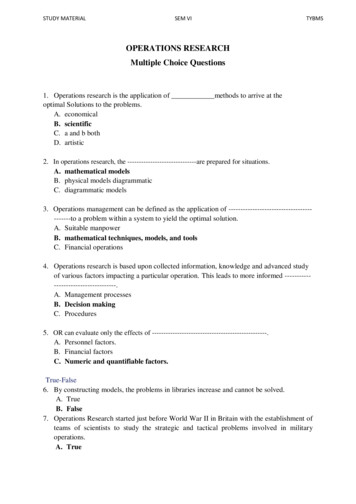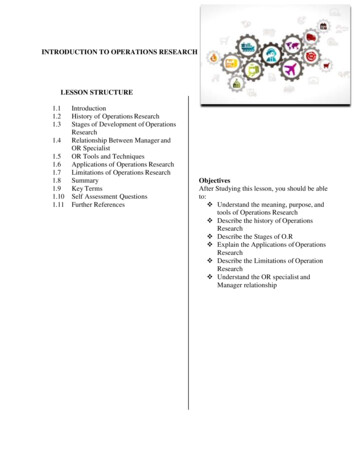
Transcription
INTRODUCTION TO OPERATIONS RESEARCHLESSON uctionHistory of Operations ResearchStages of Development of OperationsResearchRelationship Between Manager andOR SpecialistOR Tools and TechniquesApplications of Operations ResearchLimitations of Operations ResearchSummaryKey TermsSelf Assessment QuestionsFurther ReferencesObjectivesAfter Studying this lesson, you should be ableto: Understand the meaning, purpose, andtools of Operations Research Describe the history of OperationsResearch Describe the Stages of O.R Explain the Applications of OperationsResearch Describe the Limitations of OperationResearch Understand the OR specialist andManager relationship
1.1 IntroductionThe British/Europeans refer to "operational research", the Americans to "operations research" - but bothare often shortened to just "OR" - which is the term we will use.Another term which is used for this field is "management science" ("MS"). The Americanssometimes combine the terms OR and MS together and say "OR/MS" or "ORMS". Yet other termssometimes used are "industrial engineering" ("IE") and "decision science" ("DS"). In recent years therehas been a move towards a standardization upon a single term for the field, namely the term "OR".Operation Research is a relatively new discipline. The contents and the boundaries of the OR arenot yet fixed. Therefore, to give a formal definition of the term Operations Research is a difficult task.The OR starts when mathematical and quantitative techniques are used to substantiate the decision beingtaken. The main activity of a manager is the decision making. In our daily life we make the decisionseven without noticing them. The decisions are taken simply by common sense, judgment and expertisewithout using any mathematical or any other model in simple situations. But the decision we areconcerned here with are complex and heavily responsible. Examples are public transportation networkplanning in a city having its own layout of factories, residential blocks or finding the appropriate productmix when there exists a large number of products with different profit contributions and productionrequirement etc.Operations Research tools are not from any one discipline. Operations Research takes tools fromdifferent discipline such as mathematics, statistics, economics, psychology, engineering etc. andcombines these tools to make a new set of knowledge for decision making. Today, O.R. became aprofessional discipline which deals with the application of scientific methods for making decision, andespecially to the allocation of scarce resources. The main purpose of O.R. is to provide a rational basisfor decisions making in the absence of complete information, because the systems composed of human,machine, and procedures may do not have complete information.Operations Research can also be treated as science in the sense it describing, understanding andpredicting the systems behaviour, especially man-machine system. Thus O.R. specialists are involved inthree classical aspect of science, they are as follows:i) Determining the systems behaviourii) Analyzing the systems behaviour by developing appropriate modelsiii) Predict the future behaviour using these modelsThe emphasis on analysis of operations as a whole distinguishes the O.R. from other researchand engineering. O.R. is an interdisciplinary discipline which provided solutions to problems of militaryoperations during World War II, and also successful in other operations. Today business applications are
primarily concerned with O.R. analysis for the possible alternative actions. The business and industrybefitted from O.R. in the areas of inventory, reorder policies, optimum location and size of warehouses,advertising policies, etc.As stated earlier defining O.R. is a difficult task. The definitions stressed by various experts andSocieties on the subject together enable us to know what O.R. is, and what it does. They are as follows:1. According to the Operational Research Society of Great Britain (OPERATIONAL RESEARCHQUARTERLY, l3(3):282, l962), Operational Research is the attack of modern science oncomplex problems arising in the direction and management of large systems of men, machines,materials and money in industry, business, government and defense. Its distinctive approach is todevelop a scientific model of the system, incorporating measurements of factors such as changeand risk, with which to predict and compare the outcomes of alternative decisions, strategies orcontrols. The purpose is to help management determine its policy and actions scientifically.2. Randy Robinson stresses that Operations Research is the application of scientific methods toimprove the effectiveness of operations, decisions and management. By means such as analyzingdata, creating mathematical models and proposing innovative approaches, Operations Researchprofessionals develop scientifically based information that gives insight and guides decisionmaking. They also develop related software, systems, services and products.3. Morse and Kimball have stressed O.R. is a quantitative approach and described it as “ a scientificmethod of providing executive departments with a quantitative basis for decisions regarding theoperations under their control”.4. Saaty considers O.R. as tool of improving quality of answers. He says, “O.R. is the art of givingbad answers to problems which otherwise have worse answers”.5. Miller and Starr state, “O.R. is applied decision theory, which uses any scientific, mathematicalor logical means to attempt to cope with the problems that confront the executive, when he triesto achieve a thorough-going rationality in dealing with his decision problem”.6. Pocock stresses that O.R. is an applied Science. He states “O.R. is scientific methodology(analytical, mathematical, and quantitative) which by assessing the overall implication of variousalternative courses of action in a management system provides an improved basis formanagement decisions”.1.2 History of Operations ResearchOperation Research is a relatively new discipline. Whereas 70 years agoit would have been possible to study mathematics, physics orengineering (for example) at university it would not have been possibleto study Operation Research, indeed the term O.R. did not exist then. Itwas really only in the late 1930's that operational research began in asystematic fashion, and it started in the UK. As such it would beinteresting to give a short history of O.R.1936
Early in 1936 the British Air Ministry established Bawdsey Research Station, on the east coast, nearFelixstowe, Suffolk, as the centre where all pre-war radar experiments for both the Air Force and theArmy would be carried out. Experimental radar equipment was brought up to a high state of reliabilit yand ranges of over 100 miles on aircraft were obtained.It was also in 1936 that Royal Air Force (RAF) Fighter Command, charged specifically with theair defense of Britain, was first created. It lacked however any effective fighter aircraft - no Hurricanesor Spitfires had come into service - and no radar data was yet fed into its very elementary warning andcontrol system.It had become clear that radar would create a whole new series of problems in fighter directionand control so in late 1936 some experiments started at Biggin Hill in Kent into the effective use of suchdata. This early work, attempting to integrate radar data with ground based observer data for fighterinterception, was the start of OR.1937The first of three major pre-war air-defence exercises was carried out in the summer of 1937. Theexperimental radar station at Bawdsey Research Station was brought into operation and the informationderived from it was fed into the general air-defense warning and control system. From the early warningpoint of view this exercise was encouraging, but the tracking information obtained from radar, afterfiltering and transmission through the control and display network, was not very satisfactory.1938In July 1938 a second major air-defense exercise was carried out. Four additional radar stations had beeninstalled along the coast and it was hoped that Britain now had an aircraft location and control systemgreatly improved both in coverage and effectiveness. Not so! The exercise revealed, rather, that a newand serious problem had arisen. This was the need to coordinate and correlate the additional, and oftenconflicting, information received from the additional radar stations. With the outbreak of war apparentlyimminent, it was obvious that something new - drastic if necessary - had to be attempted. Some newapproach was needed.Accordingly, on the termination of the exercise, the Superintendent of Bawdsey Research Station, A.P.Rowe, announced that although the exercise had again demonstrated the technical feasibility of the radarsystem for detecting aircraft, its operational achievements still fell far short of requirements. Hetherefore proposed that a crash program of research into the operational - as opposed to the technical aspects of the system should begin immediately. The term "operational research" [RESEARCH into
(military) OPERATIONS] was coined as a suitable description of this new branch of applied science.The first team was selected from amongst the scientists of the radar research group the same day.1939In the summer of 1939 Britain held what was to be its last pre-war air defence exercise. It involved some33,000 men, 1,300 aircraft, 110 antiaircraft guns, 700 searchlights, and 100 barrage balloons. Thisexercise showed a great improvement in the operation of the air defence warning and control system.The contribution made by the OR team was so apparent that the Air Officer Commander-in-Chief RAFFighter Command (Air Chief Marshal Sir Hugh Dowding) requested that, on the outbreak of war, theyshould be attached to his headquarters at Stanmore in north London.Initially, they were designated the "Stanmore Research Section". In 1941 they were redesignatedthe "Operational Research Section" when the term was formalised and officially accepted, and similarsections set up at other RAF commands.1940On May 15th 1940, with German forces advancing rapidly in France, Stanmore Research Section wasasked to analyses a French request for ten additional fighter squadrons (12 aircraft a squadron - so 120aircraft in all) when losses were running at some three squadrons every two days (i.e. 36 aircraft every 2days). They prepared graphs for Winston Churchill (the British Prime Minister of the time), based upona study of current daily losses and replacement rates, indicating how rapidly such a move would depletefighter strength. No aircraft were sent and most of those currently in France were recalled.This is held by some to be the most strategic contribution to the course of the war made by OR(as the aircraft and pilots saved were consequently available for the successful air defense of Britain, theBattle of Britain).1941 onwardIn 1941, an Operational Research Section (ORS) was established in Coastal Command which was tocarry out some of the most well-known OR work in World War II.The responsibility of Coastal Command was, to a large extent, the flying of long-range sorties bysingle aircraft with the object of sighting and attacking surfaced U-boats (German submarines). Thetechnology of the time meant that (unlike modern day submarines) surfacing was necessary to rechargebatteries, vent the boat of fumes and recharge air tanks. Moreover U-boats were much faster on thesurface than underwater as well as being less easily detected by sonar.
Thus the Operation Research started just before World War II in Britain with the establishmentof teams of scientists to study the strategic and tactical problems involved in military operations. Theobjective was to find the most effective utilization of limited military resources by the use of quantitativetechniques. Following the end of the war OR spread, although it spread in different ways in the UK andUSA.In 1951 a committee on Operations Research formed by the National Research Council of USA,and the first book on “Methods of Operations Research”, by Morse and Kimball, was published. In 1952the Operations Research Society of America came into being.Success of Operations Research in army attracted the attention of the industrial mangers whowere seeking solutions to their complex business problems. Now a days, almost every organization in allcountries has staff applying operations research, and the use of operations research in government hasspread from military to wide variety of departments at all levels. The growth of operations research hasnot limited to the U.S.A. and U.K., it has reached many countries of the world.India was one the few first countries who started using operations research. In India, RegionalResearch Laboratory located at Hyderabad was the first Operations Research unit established during1949. At the same time another unit was set up in Defense Science Laboratory to solve the Stores,Purchase and Planning Problems. In 1953, Operations Research unit was established in Indian StatisticalInstitute, Calcutta, with the objective of using Operations Research methods in National Planning andSurvey. In 1955, Operations Research Society of India was formed, which is one of the first members ofInternational Federation of Operations Research societies. Today Operations Research is a popularsubject in management institutes and schools of mathematics.1.3 Stages of Development of Operations ResearchThe stages of development of O.R. are also known as phases and process of O.R, which has siximportant steps. These six steps are arranged in the following order:Step I: Observe the problem environmentStep II: Analyze and define the problemStep III: Develop a modelStep IV: Select appropriate data inputStep V: Provide a solution and test its reasonableness
Step I: Observe the problem
Operation Research is a relatively new discipline. The contents and the boundaries of the OR are not yet fixed. Therefore, to give a formal definition of the term Operations Research is a difficult task. The OR starts when mathematical and quantitative techniques are used to substantiate the decision being taken. The main activity of a manager is the decision making. In our daily life we make the decisions
